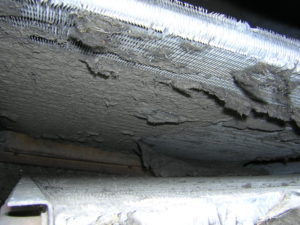
What Happens When a Coil is Loaded with Dirt?
Finned tube coils are meant to have contact with the air flow, as more contact creates more heat transfer. Heat transfer is nothing more than heat exchanged from one medium to another, and the goal is to create maximum heat transfer efficiency. The downside to this process is the coil’s susceptibility to foreign materials becoming lodged in them. The following explores this problem in a little more depth.
Tubes in a coil are the “primary surface”, and the fins are the “secondary surface”. In a heating coil, the water or steam is hotter than the air going across the outside finned-tube surface. The heat is removed from the fluid and transferred to the air. In a cooling coil, the water or refrigerant is cooler than the air, and the heat from the air is transferred to the water or refrigerant. All of this can be calculated by our computer coil selection programs. However, these programs are BTUH capacity based on a clean coil. The term “clean coil” means no internal or external fouling. It’s like the miles per gallon you see on a new car sticker that represents a perfect test versus the results you get with normal driving. The same goes for coils.
Finned Tube Fouling
As stated, the finned tube design is meant to have maximum contact with the air. Because of this, internal portions of a coil core can begin to “load up” from dirt and debris. Most times, it’s because the upstream filters have not been changed or are inadequate for the system. Many systems still have the old type furnace filter which is equal to a MERV 6 rating. Even MERV 8 filters are not adequate for most HVAC systems. They do not remove enough particulate, especially when they’re not replaced on a regular basis. This will “load up” the downstream coil.
When a downstream coil is loaded, the air resistance is increased. The system was sized for an internal unit resistance, and one of the main resistances in an air handler is the coils. The air flow amount can fall as much as 15% to 25% based on this fouling. Many operators see this decrease and speed up the fan to overcome the added resistance. This only adds to the operating cost of the unit, as the brake horsepower and overall power consumption will increase substantially.
The coil also has more “insulation” between the fluid inside the tubes and the air outside the tubes. The dirt will act as an insulating pad between the two streams, and you can lose 10% of your heat transfer due to this factor. The dirt buildup isn’t always uniform across the entire face of the coil. We’ve seen water carryover in cooling coils, because a local velocity through a more opened area of the coil rises above the velocity where carryover can occur.
USA Coil & Air has some designs that can assist you with these problems:
- Reducing the number of fins per inch for a replacement
- Reduction in rows in the direction of air flow for a replacement
- Providing a flat fin surface that doesn’t load dirt as quickly
- Heavier fin surfaces that allow high pressure cleaning without fin damage
Tube Side Fouling
The inside header and tube surface of most coils installed in today’s HVAC systems are not cleanable. Many systems are not pure water, steam, or refrigerant; and the inside surface can cause performance problems. This is usually unknown, as you can’t see inside a coil unless you disconnect the coil connections. It may still be difficult, as you will only be able to see a few inches into the coil.
Water (glycol) and steam are both treated. Sometimes there is also a lack of treatment that is every bit as bad. With these treatments, the fluids can begin to have clogging affects with the inside tube surface. Condensate especially can almost close tubes after a long time in service. It’s important to understand that the internal fouling acts as an insulator between the fluid inside the tubes and the air outside the tubes. The capacity can be severely reduced.
USA Coil & Air has some designs that can assist you with these problems:
- Cleanable tube coils with removable plugs
- Cleanable tube coils with removable headers at one or both ends
- Larger tube diameters to reduce the build ups inside the tubes
USA Coil & Air is here to assist you with solving problems, not creating new ones. Why purchase new coils without fixing the problem? We can provide you with a quality engineering review and offer alternatives that will work for you. Even better, we can usually produce the coil in as little as 5 working days.
